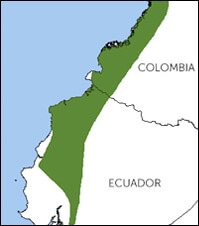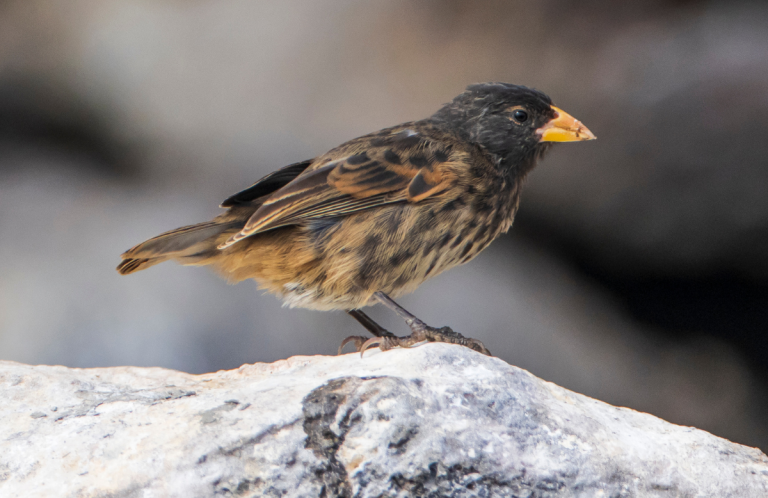 The all-black male sports a crest of fine, hair-like feathers that hang all the way over its bill, giving it the look of having an “umbrella.” This unusual species also has an inflatable wattle dangling from the middle of its chest. This long wattle is covered in short, scaly feathers, and when inflated, looks somewhat like a pine cone! During mating season, the male puts these ornaments into action.
The all-black male sports a crest of fine, hair-like feathers that hang all the way over its bill, giving it the look of having an “umbrella.” This unusual species also has an inflatable wattle dangling from the middle of its chest. This long wattle is covered in short, scaly feathers, and when inflated, looks somewhat like a pine cone! During mating season, the male puts these ornaments into action.
Females and immature birds are only half the size of males, and the wattle is much smaller or absent altogether.
Habitat Loss & Other Threats
The biggest threat to the Long-wattled Umbrellabird is habitat loss due to development, logging, road-building, and gold mining. Intensive agricultural development is a major deforestation factor, especially for oil palm and banana plantations and livestock-farming. And, since this is a large and relatively conspicuous species, some local people capture them as pets, for sale to third parties, or to eat.
Loud Lekking Umbrellabird
Long-wattled Umbrellabirds prefer the mid-level to upper story of tall trees. They are rather clumsy flyers and prefer to hop from branch to branch within the tree canopy.
Sign up for ABC's eNews to learn how you can help protect birds
Like other birds such as Buff-breasted Sandpiper and Pin-tailed Manakin, male Long-wattled Umbrellabirds gather at established sites, called “leks.” Here, they display to females, who visit to pick the “best” male to father their brood. Male umbrellabirds show off by raising their crests, inflating and swinging their long wattles, and making loud, grunting calls and low-frequency booming sounds which can be heard up to almost a mile away.
After mating, the female builds a loosely-built platform nest of twigs, incubates the eggs, and broods her chicks alone. The first Long-wattled Umbrellabird nest was only discovered by scientists in 2003.

Long-wattled Umbrellabird female by Dušan M. Brinkhuizen
The diet of the Long-wattled Umbrellabird is composed of insects, lizards, and fruit, especially palm-nuts. They regurgitate the larger seeds of the fruits they eat, so are important “farmers” that help disperse seeds and regenerate the tropical forests where they live.
Conserving the Chocó
The Long-wattled Umbrellabird's limited range falls within the Chocó region of western Colombia and Ecuador. ABC partner Fundación Jocotoco protects more than 6,100 acres of this forest at the Rio Canandé Reserve in northwestern Ecuador, where the umbrellabird and many other threatened birds–such as the Scarlet-breasted Dacnis and Great Green Macaw—can be found.
ABC and Jocotoco also established the Buenaventura Reserve in southwestern Ecuador in 1999 to help protect this habitat. The reserve now spans more than 3,700 acres and boasts a list of over 300 bird species, including the endangered El Oro Parakeet, the Ochraceous Attila, and the Club-winged Manakin.
A modern guest facility, named the “Umbrellabird Lodge” was opened at Buenaventura in 2006, and visitors can easily hike to a lek of Long-wattled Umbrellabirds nearby, making this one of the easiest places to see this fantastic bird.
Inspired by the Umbrellabird?
Inspired to help the birds of Buenaventura Reserve? ABC is partnering with World Land Trust to support Jocotoco in the purchase of a 233-acre addition that will expand the existing reserve. This land purchase ensures that birds like the Long-wattled Umbrellabird and El Oro Parakeet have a permanent home.
If you donate now, your financial support will trigger matching funds and help us meet our campaign goal. Will you join our global campaign and help protect the Long-wattled Umbrellabird?
Donate to support ABC's conservation mission!



















































